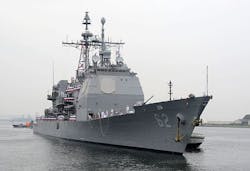The U.S. Navy is shrinking the size of its gargantuan 1970s-era shipboard computers
The Military & Aerospace Electronics take:
26 April 2019 -- The heart of the U.S. Navy’s shipboard defenses is the Aegis Combat System. At one time the hardware used to run Aegis was large and took up a significant portion of the ship.
For a missile test last March the destroyer USS Hudner ran its Aegis hardware from what the Navy calls a “virtual twin,” a handful of modern computers in ruggedized boxes to emulate the Aegis computer system and software but in a much smaller package.
The use of virtualization will make upgrades to shipboard computers—particularly Aegis—easier and cheaper than ever before. While previously the Navy had to cut holes into its ships to remove and replace computers and other electronics, now the older computers can be disassembled to manageable pieces and then their replacements wheeled aboard without any cutting involved.
Related: Lockheed Martin to upgrade Aegis computer equipment on Navy cruisers and destroyers
Related: DRS Laurel chosen to manufacture open-systems rugged computers for Navy surface warships
John Keller, chief editor
Military & Aerospace Electronics
Ready to make a purchase? Search the Military & Aerospace Electronics Buyer's Guide for companies, new products, press releases, and videos
